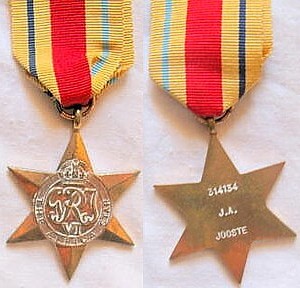
The Africa Star is a military campaign medal, instituted by the United Kingdom on 8 July 1943 for award to British and Commonwealth forces who served in North Africa between 10 June 1940 and 12 May 1943 during the Second World War.

The Nkwe ya Boronse - Bronze Leopard, post-nominal letters NB, is a military decoration for bravery which was instituted in 2003. It is South Africa's third highest military decoration for bravery.

The Baltic Medal was a campaign medal approved in 1856, for issue to officers and men of the Royal Navy, Royal Marines, and Royal Sappers and Miners who served in Baltic Sea operations against Russia in the Baltic theatre of the Crimean War between March 1854 and August 1855. The medal primarily covered naval actions but was also awarded to 106 men of the Royal Sappers and Miners who were landed to place demolition charges against Russian fortifications at Bomarsund and Sveaborg.
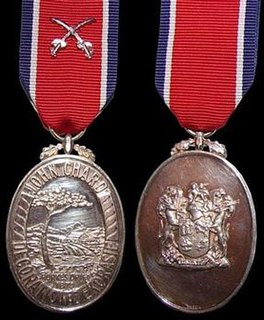
The John Chard Decoration, post-nominal letters JCD, was a military long service decoration which was instituted by the Union of South Africa on 6 April 1952. It was awarded to members of the Citizen Force of the South African Defence Force for twenty years of efficient service and good conduct. Clasps could be awarded after thirty and forty years service respectively.

The King Edward VII Coronation Medal was a commemorative medal issued in 1902 to celebrate the coronation of King Edward VII and Queen Alexandra.
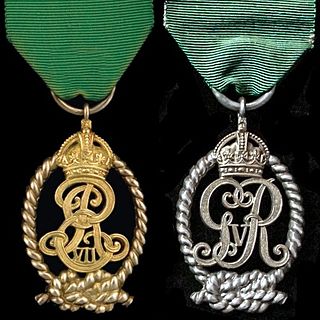
The Decoration for Officers of the Royal Naval Volunteer Reserve, post-nominal letters VD until c. 1947 and VRD thereafter, was instituted in 1908. It could be awarded to part-time commissioned officers in the United Kingdom's Royal Naval Volunteer Reserve after twenty years of service as efficient and thoroughly capable officers. The decoration was a Naval version of the Volunteer Officers' Decoration and its successor, the Territorial Decoration.

The Efficiency Decoration, post-nominal letters TD for recipients serving in the Territorial Army of the United Kingdom or ED for those serving in the Auxiliary Military Forces, was instituted in 1930 for award to part-time officers after twenty years of service as an efficient and thoroughly capable officer. The decoration superseded the Volunteer Officers' Decoration, the Colonial Auxiliary Forces Officers' Decoration and the Territorial Decoration.

The Efficiency Decoration , post-nominal letters ED, was instituted in 1930 for award to efficient and thoroughly capable part-time officers in the Citizen Force of the Union of South Africa after twenty years of service. The decoration superseded the Colonial Auxiliary Forces Officers' Decoration.

The John Chard Medal is a military long service medal which was instituted by the Union of South Africa on 6 April 1952. Until 1986, it was awarded to members of the Citizen Force of the South African Defence Force for twelve years of efficient service and good conduct. The period of qualifying service was reduced to ten years in 1986.
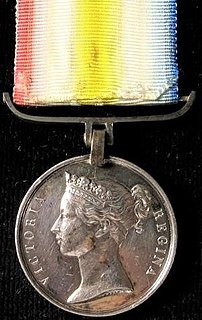
The Scinde Medal was authorised on 22 September 1843 and issued to soldiers of the Honourable East India Company, the 22nd Regiment of Foot of the British Army and members of the Indian Navy who manned the Indus Flotilla, who participated in Major General Sir Charles Napier's conquest of Scinde between 1842 and 1843.

The Army Medal is the maximum military award of Spain in peacetime for the army branch. The regulation for the issue of this medal is modified by the Royal Decree 1040/2003, 1 August.
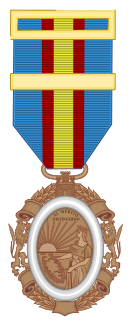
The Air Force Medal is the maximum military award of Spain in peacetime for the air force branch. The regulation for the issue of this medal is modified by the Royal Decree 1040/2003, 1 August.

The Colonial Auxiliary Forces Officers' Decoration, post-nominal letters VD, was established in 1899 as recognition for long and meritorious service as a part-time commissioned officer in any of the organized military forces of the British Colonies, Dependencies and Protectorates. It superseded the Volunteer Officers' Decoration for India and the Colonies in all these territories, but not in the Indian Empire.

The Royal Naval Volunteer Reserve Long Service and Good Conduct Medal, initially designated the Royal Naval Volunteer Reserve Long Service Medal, was instituted in 1908. It could be awarded to part-time ratings in the United Kingdom's Royal Naval Volunteer Reserve after twelve years of service and good conduct. The medal was a Naval version of the Volunteer Long Service Medal and its successor, the Territorial Force Efficiency Medal.
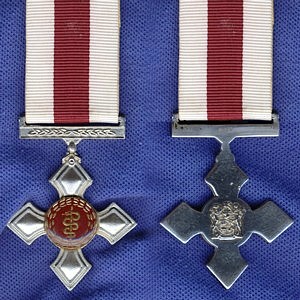
The Medical Service Cross, post-nominal letters CC, is a military decoration which was instituted by the Republic of South Africa in 1987. It was awarded to members of the South African Medical Service for bravery. The Medical Service Cross was discontinued in 2003, but backdated awards can still be made for acts of bravery during this period.

The Southern Cross Medal of 1975, post-nominal letters SM, is a military decoration which was instituted by the Republic of South Africa on 1 July 1975. It was awarded to officers of the South African Defence Force for exceptionally meritorious service and particular devotion to duty.

The Pro Merito Medal of 1975, post-nominal letters PMM, is a military decoration which was instituted by the Republic of South Africa on 1 July 1975. It was awarded to other ranks of the South African Defence Force for exceptionally meritorious service and particular devotion to duty, and was the non-commissioned officers' version of the Southern Cross Medal of 1975 (SM).
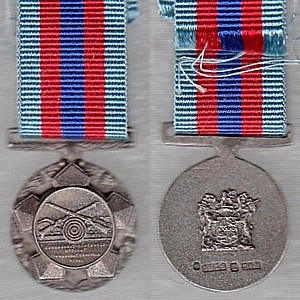
The Commandant General's Medal is a military marksmanship medal which was created by the Commandant General of the South African Defence Force in 1962 and formally instituted by the State President in 1965. It was awarded to the champion shot of the annual South African Defence Force Shooting Championships from 1962 to 1975. The year the award was earned, is shown on a bar which is worn on the ribbon. The award could be won multiple times, with each subsequent award indicated by an additional bar.

The SADF Champion Shot Medal is a military medal which was instituted by the Republic of South Africa in 1975. It was awarded to the champion shots of the annual South African Defence Force Shooting Championships in the categories of full-bore, small-bore, service shooting and pistol. The medal could be won multiple times, with each subsequent award indicated by a bar.

The Faithful Service Medal was instituted by the State President of the Republic of Transkei in 1987, for award to all ranks as a long service medal.
























